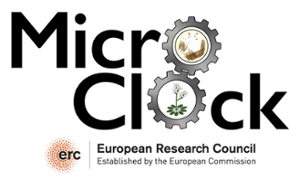Research project
MicroClock: The Bacillus subtilis circadian clock, from molecules to mutualism
The central aims of MicroClock project are to describe the B. subtilis circadian clock at molecular and functional levels, and discover the mechanisms of clock-regulated bidirectional signaling between B. subtilis and the model plant Arabidopsis
- Duration
- 2025 - 2031
- Contact
- Akos Kovács
- Funding
-
 ERC Synergy
ERC Synergy
- Partners
- Martha Merrow
- LMU Munich and Antony Dodd
- John Innes Centre
- Norwich

Circadian clocks are biological timekeepers. They structure processes—from molecular pathways to behavioral attributes—over the 24h day. They are pervasive in eukaryotes yet remain almost completely unknown in non-photosynthetic bacteria, despite these being the most ancient lifeforms on Earth that evolved for 4 billion years under environmental cycles caused by the Earth’s rotation. We are addressing this major knowledge gap by capitalizing on our recent discovery of a circadian clock in Bacillus subtilis. Furthermore, we propose that the mutualistic interactions between microbes and organisms in their environment utilize circadian clocks.
- Sartor F, Xu X, Popp T, Dodd AN, Kovács ÁT, Merrow M (2023) The circadian clock of the bacterium B. subtilis evokes properties of complex, multicellular circadian systems. Science Advances 9(31): eadh1308 (https://doi.org/10.1126/sciadv.adh1308)
- Sartor F, Kovács ÁT (2022) Rhythmic spatial self-organization of bacterial colonies. mBio Journal 13(4): e01703-22 (Commentary) (https://doi.org/10.1128/mbio.01703-22)
- Eelderink-Chen Z, Bosman J, Sartor F, Dodd A, Kovács ÁT, Merrow M (2021) A circadian clock in a nonphotosynthetic prokaryote. Science Advances 7(2):eabe2086 (https://doi.org/10.1126/sciadv.abe2086)
- Sartor F, Eelderink-Chen Z, Aronson B, Bosman J, Hibbert L, Dodd A, Kovács ÁT, Merrow M (2019) Are there circadian clocks in non-photosynthetic bacteria? Biology 8(2): 41 (https://doi.org/10.3390/biology8020041)
